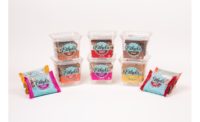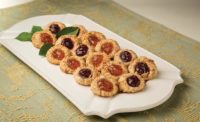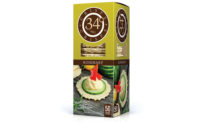In the highly competitive food industry, it’s pretty rare for 1 percent of the population to drive a major trend, but such is the case with gluten-free. According to the National Foundation for Celiac Awareness, just 1 percent of Americans are diagnosed with celiac disease, an autoimmune condition that can lead to small intestine damage, an inability to absorb nutrients and other health issues when gluten is consumed. For these shoppers, gluten-free products are a necessity.
So why is it, according to the January 2015 “Gluten-Free Foods in the U.S., 5th Edition” report from Packaged Facts, that gluten-free sales are growing 34 percent annually and reached $973 million in 2014 alone?
“With only a small fraction of Americans choosing to eat gluten-free as a consequence of dietary restrictions, the state of the market for such products has expanded to encompass more consumers,” explains Martin Neumann, sales director, Gaslamp Popcorn, Riverside, CA. “When asked by Mintel the reason they currently eat or used to eat gluten-free versions of foods, most consumers (82 percent) said their decision was unrelated to diagnosis of celiac disease. As a matter of fact, more than a quarter of them are or were testing to see if they are gluten-intolerant or -sensitive, and a quarter of them admitted to eating gluten-free foods for weight loss.”
According to Dave Sheluga, director of consumer insights and marketing, Ardent Mills, Denver, the company’s recent consumer interviews in Portland, OR, yielded one telling response: Gluten-free is the new black. “The comparison to a fashion trend is a clear sign that gluten-free is still buzzworthy,” he says.
Under the microscope
Demand for gluten-free foods, across the board, is higher than ever. The biggest opportunities truly lie, however, with bakery and snack items, which are perhaps the most highly scrutinized categories within the gluten-free market. And while many consumers look to gluten-free products for perceived health benefits, “the top-selling categories for gluten-free specialty products are snacks—in particular, snack chips and snack bars,” says Sheluga. “Despite the promise of a product being healthier because it’s gluten-free, the real truth is that snack products are the best-sellers.”
According to Doon Wintz, president, Wholly Wholesome, Chester, NJ, the bakery industry is also under a particularly sharp microscope because, while “there are so many corn- and potato-based snacks that may be inherently gluten-free, bakery products are so gluten-centric that finding great-tasting, truly gluten-free baked goods is a personal mission for many.”
This is because consumers, who were previously relieved to find any gluten-free baked goods on the market, are raising their standards, says Cesar Zelaya, bakery technology manager, Handtmann Inc., Lake Forest, IL, to also include “expectations regarding the attributes of the finished product, such as volume, crumb structure and texture.”
Zelaya notes that his company works to gently handle gluten-free doughs and batters to ensure that proper volume and bread characteristics are achieved. “Also, for gluten-free baked goods that contain inclusions such as chocolate chips or nuts, our patented vane cell technology maintains the integrity through the portioning or depositing process of gluten-free dough and batters for the best finished product quality,” he adds.
“When competition was limited, the only thing that seemed to matter was speed and accuracy,” says John McIsaac, vice president of strategic business development, Reiser, Canton, MA. “Now, producers are very focused on product appearance. This can mean more evenly topped loaves of bread, fewer holes in the bread, better crumbs or inclusions.”
When someone follows a gluten-free diet, says Sarah Wood, Ph.D., manager of research and development, Penford Food Ingredients, Englewood, CO, snacks are largely off-limits, as well. “Gluten-free snacks and baked goods are under the microscope because it is easy to compare these gluten-free products to their gluten-containing equivalents,” she says. “Consumers expect the gluten-free snack or baked good to be of similar taste and quality as their traditional gluten-containing counterparts. For example, a gluten-free chocolate chip cookie should taste just like the chocolate chip cookies you remember your mom baking.”
Navigating challenges
Consumer comparison is just one challenge plaguing this burgeoning industry. The largest challenge lies in gluten-free certification itself. “Any plant that has gluten as an ingredient is at risk of a human making a mistake resulting in cross-contamination,” says Wintz. Regardless of how much you test or the Good Manufacturing Practices (GMPs) you have in place, humans make mistakes, he says.
That’s why companies establish stringent quality-control measures to ensure that any gluten-free product is, in fact, gluten-free. Wintz notes that his company starts the process with its certified gluten-free raw materials, which are assayed on inbound receipt to assure they’re gluten-free, he says. “We also test our finished goods, just to be extra sure. We exceed almost every standard that is out there. Our facility is dedicated gluten-free. We test to less than 5 parts per million, which is the most sensitive test we can perform onsite.”
Sanitary design is also top of mind. “Gluten-free manufacturers are concerned about contamination, especially if they run non-gluten-free products on the same equipment,” McIsaac says. “Therefore, we strive to make the machinery easily cleanable.”
While some bakery equipment is designed to account for the fact that a kill step during baking at a high temperature will destroy any unhygienic components, this doesn’t work when it comes to eliminating gluten. “Our machines are used across multiple industries, including many ready-to-eat applications, with no freeze or bake step,” says McIsaac. “As such, we need to make sure that our machines and our attachments are completely cleanable.”
Equipment with stainless steel surfaces and FDA-accepted plastics in the product zones, including attachments that are easily disassembled, cleaned, inspected and reassembled, “often without tools,” he adds, set manufacturers on the right path.
Gluten-free manufacturers often require all ingredient suppliers to be certified gluten-free to help reduce the chance of cross-contamination. “Receiving and segregating ingredients is also part of the standard operating procedures,” says Leslie Kaplan, co-founder, The Piping Gourmets, Miami. “We also have standard operating procedures for receiving to be sure that what we are receiving matches up with our ingredient list. All manufacturing is in a dedicated gluten-free facility and is on dedicated gluten-free equipment.”
Completely segregating gluten-free manufacturing from gluten-containing manufacturing (if there is any) is one approach to managing cross-contamination. But this represents another challenge that snack and bakery manufacturers face when transitioning to gluten-free products: cost.
“The greatest challenge we typically see when trying to meet gluten-free demands is changing processing, in addition to the necessary changes in ingredients,” explains Amanda Higgins, quality control manager, Gum Technology, a business unit of Penford Food Ingredients. “A change in processing can be costly, as it can mean a change in equipment. It can also mean a change in procedures for handling goods, containment or additional quality testing.”
Manufacturers can also experience this shift when gluten-free artisan products outgrow their current manufacturing processes and equipment. “Most gluten-free bakers started their operation manually or with minimal equipment involved in the production process,” Zelaya says. “As their production demand grows, they need to automate their process. It is critical that during the automation process, the product characteristics are preserved.” Therefore, Handtmann works to ensure its equipment can process dough and batter very gently to produce artisan-looking products.
But even ingredient swaps can be difficult. “The challenge then becomes creating a solution utilizing gums and starches to recreate texture without compromising processing methods,” says Higgins. Indeed, texture is huge in the bakery world—an attribute often achieved by the wheat flour base.
To achieve desirable taste and texture in gluten-free foods, manufacturers have to experiment with alternative ingredients. According to Angela Ichwan, senior director of research and technical solutions, Ardent Mills, whole sorghum flour works well in foods that are comparatively high in moisture (like breads and muffins), though too much sorghum can impart grittiness in certain types of cookies. The good news is that sorghum is readily available and lower in cost compared to alternatives like quinoa or amaranth, two other gluten-free mainstays.
“The use of multigrain blends of ancient grain flours in combination with brown or white rice and tapioca, potato or other starches is one way to customize the flour for functionality, nutrition and cost,” Ichwan suggests. “Product developers need to work closely with their flour suppliers to ensure that taste, texture, nutrition, availability and cost targets are met.”
Finally, manufacturers operating in the gluten-free space need to constantly make themselves aware of changing trends, just like the rest of the food industry. “Gluten-free products are not fad items,” says Wood. “As awareness and diagnosis of celiac disease and gluten intolerance continues, the need for high-quality gluten-free snacks and baked goods will increase as well.”











